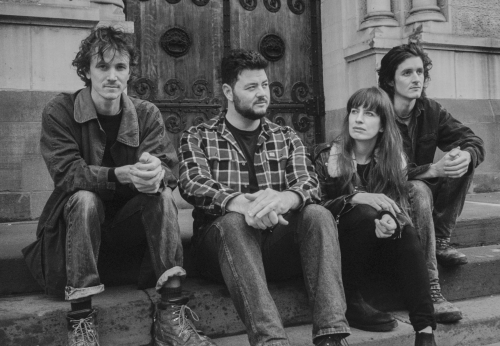The Felice Brothers

The Felice Brothers’ album, Life in the Dark, out on Yep Roc, is classic American music. At once plainspoken and deeply literate, the band’s latest features nine new songs that capture the hopes and fears, the yearning and resignation, of a rootless, restless nation at a time of change.
Life in the Dark also coincides with The Felice Brothers’ 10th anniversary as a band. Hailed by the AV Club for a sound at once “timeless, yet tossed-off,” they’ve released plenty of music over the past decade, often on their own without a record label, but the new album is the fullest realization yet of the band’s DIY tendencies. Self-produced by the musicians and engineered by James Felice (who also contributed accordion, keyboards and vocals), the Felice Brothers made Life in the Dark themselves in a garage on a farm in upstate New York, observed only by audience of poultry.
“The recording is definitely rough around the edges and cheap,” James Felice says, laughing. “It was liberating and really cool to do. It allowed us to untether ourselves from anything and just make music.”
Because of makeshift studio set-up, the music they made was necessarily stripped down, emphasizing acoustic instruments and spacious arrangements on songs that showcase the sound of a band playing together live, with echoes in the music of Woody Guthrie, Townes Van Zandt, John Prine and rural blues.
“We tried to make it as simple and folk-based as possible, because we were working with limited resources,” singer and guitarist Ian Felice says. “We wanted to take all the frills out and make it just meat and potatoes.”
Still, there are hints of seasoning: among the folk and blues touchstones, the band took a certain inspiration from Neil Young and the Meat Puppets, too. Ian Felice says he was trying to channel the spirit of Meat Puppets II on opener “Aerosol Ball” — “They played kind of weird, freaky folk music, so there’s a connection there,” he says — while James Felice says listening to Neil Young’s Tonight’s the Night was like getting permission to make Life in the Dark.
“If you listen to that record, it’s fucking crazy,” he says. “We listened to that to know that what we were doing was legal and had precedent. If Neil Young could make a record that sounds like that, we can make a record that sounds like this.”
He’s referring to the wild, whirling accordion and big, loose rhythm on “Aerosol Ball,” mournful glimmers of electric guitar and fiddle on “Triumph ’73” and the ramshackle, blues-rock feel of “Plunder,” full of grainy lead guitars, blasts of organ and a shout-along chorus inspired by the rhythm of Shakespeare’s “Double, double toil and trouble” incantation in Macbeth. Though The Felice Brothers often share songwriting duties, the band gravitated toward Ian Felice’s songs for Life in the Dark.
Along with Shakespeare and the Meat Puppets, Ian Felice absorbed the essence of writers from Anne Sexton to Anne Frank, Raymond Carver to Dr. Seuss, on tunes with clear, if unintentional, political undertones. “It’s just what was going on when I was writing the songs,” Ian Felice says. “It’s a pretty politically charged climate right now.” To say the least.
The singer’s characters on “Aerosol Ball” exist in a dystopian culture bought, and ruled, by corporations; while “Jack at the Asylum” catalogs cultural ills including climate change, economic inequality and the numbing aspects of televised warfare, themes that recur again on “Plunder.” He wrote the title track after re-reading The Diary of a Young Girl, the journal that Frank kept while in hiding from the Nazis during World War II. “The idea of living in a dark attic unable to fully grasp what is going on in your life and feeling powerless to change it seemed like a relevant metaphor for me at the time,” Ian Felice says.
Elsewhere, he offers his own interpretation of classic American archetypes: “Triumph ’73” follows a young man on the cusp of adulthood desperate to ride his motorcycle away from the life changes overtaking him, while the ballad “Diamond Bell” tells the story of a folk heroine gunslinger in the vein of Pretty Boy Floyd or Jesse James, and the hapless, lovestruck kid she ensnares. “It’s part-love song, part-adventure story, part-tragedy, told in the Mexican folk tradition of singing about bandits,” Ian Felice says. “I think it’s one of the most straight-ahead narratives I’ve written.”
The band, spent about a month recording Life in the Dark in the late winter of 2015. James Felice learned engineering on the fly — “I literally had a book, like, ‘Where do you put the mic? How do you mic the kick drum?’” he says — and the band managed to nail most of the tunes within a few takes.
“There wasn’t too much agonizing, just the joy of playing music,” James Felice says. “We had an audience of chickens, and an audience of each other, and we were just really enjoying making it.”
The resulting album is more than just classic American music — it’s a parable for modern America.